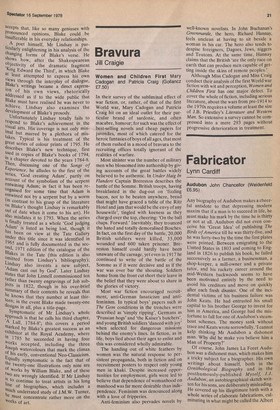Art and the man
Martin Butlin William Blake, His Life and Works Jack Lindsay (Constable 29.50) In the case of few artists more than Wil" ham Blake can it truly be said that the art was the man. His art expressed his deepest thoughts and feelings and these in their turn both reflected and jail', enced his life. Thus the narrative form 0' this new account of Blake's life and thought is ideal in the way it brings out the interaction between his life and beliefs, and between these beliefs and their expression. It makes a valuable contribution, somewhere between on the one hand the biographies of Alexander christ (first published in 1863 but still essential reading) and Mona Wilson (Lindsay strangely omits from his bib' liography the latest, posthumous edition of 1971 with valuable revisions by Gen'frey Keynes) and on the other the scho larly examinations of Blake's thought that, even in the best cases, have tended to frighten off the general reader. Mr Lindsay has all the advantages .of the outsider with few of the dtsadvantages. He displays a remarkahlY comprehensive appreciation of the various forces, intellectual, social and political, that affected Blake's development. acknowledges a particular debt to Dav" Erdman's establishment of Blake as a political thinker, and his own beliefs enable him to see Blake in some ways a forerunner of Hegel and Marx, but he never allows this to distort his account' Similarly he is remarkably level-headed in balancing the influences of the various sources on which Blake drew: fnr instance, that of Neo-Platonism is ack: nowledged but not made a predominant factor as it has been by adherents of the 'Tradition'. Lindsay will not please everY school of Blake criticism — indeed it would be amazing, and worrying, if Ilet did — but his summary of Blake's thoug" is the most convincing yet published. In addition Lindsay clearly delnnadstrates how Blake's thought changed a.° , developed. His knowledge of the politica' scene enables him to assess the influence of the American and French RevolutioOs, and to chart very precisely the growing danger to radical expression in the 1790s" He also clarifies the way in which, as hopes of political reform faded, Blakhe looked for man's salvation on this earl", first to an apocalyptic judgement-day an' eventually to a form of quietism based on the teachings of Christ. In this he sees 3 weakening of Blake's stand; ecluallY refreshing is the candour with which he accepts that, like so many geniuses with pronounced opinions, Blake could be insufferable in his everyday relationships. A poet himself, Mr Lindsay is particularly enlightening in his analysis of the changing forms of Blake's verse. He Shows how, after the Shakespearean Objectivity of the dramatic fragment King Edward the Third', in which Blake at least attempted to express his own views through the interplay of dialogue, Blake's writings became a direct expression of his own views, rhetorically addressed as if to the wide public that Blake must have realised he was never to achieve. Lindsay also examines the development of Blake's prosody. Unfortunately Lindsay totally fails to respond to Blake's achievement in the Yisual arts. His-coverage is not only minMal but marred by a plethora of mistakes. Typical is his treatment of the great series of colour prints of 1795. He describes Blake's new technique, first used in copies of Blake's books of 1794, in a chapter devoted to the years 1784-8. Then, discussing one of the Songs of Experience, he alludes to the first of the series, 'God creating Adam', partly on account of the symbolism of the serpent entwining Adam; in fact it has been recognised for some time that Adam is entwined not by a serpent but by a worm (in contrast to his grasp of the literature en Blake's thought Lindsay is remarkably out of date when it come to his art). He also misdates it to 1793. When the series is finally treated as a whole 'God judging Adam' is listed as being lost, though it has been on view at the Tate Gallery under this title since it was identified in 1965 and is fully documented in the second, 1971 edition of the catalogue of the Blakes in the Tate (this edition is also omitted from Lindsay's bibliography); Lindsay also invents a new subject, Adam cast out by God'. Later Lindsay states that John Linnell commissioned ten rather than twenty engravings of Job subjects in 1822, though in his over-brief summary of their contents he reveals that he knows that they number at least thirteen; in the event Blake made twenty-one designs in all, plus a title-page. SYmptomatic of Mr Lindsay's whole 1:iproach is that he calls his third chapter, A Lull, 1784-8'; this covers a period marked by Blake's greatest success as an exhibitor at the Royal Academy, where in 1785 he succeeded in having four Works accepted, including the three Joseph watercolours that mark the climax uf his early, conventional Neo-Classicism. Equally symptomatic is the fact that of the twenty-one illustrations only nine are of works by William Blake, and of these tWO are wrongly identified. If Mr Lindsay I! to continue to treat artists in his long hrle of biographies, which includes a lunch underrated study of J.M.W. Turner, he must concentrate rather more on the works of art.



































 Previous page
Previous page